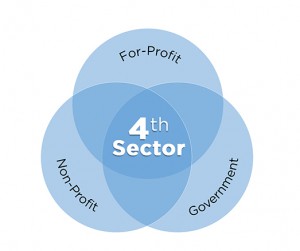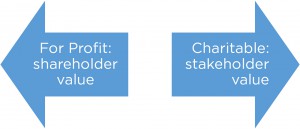“Do Well by Doing Good”
Source: Region’s Business
This oft used quote by Ben Franklin is finding new life in the convergence of two worlds: the for-profit and the charitable.
By RoseAnn B. Rosenthal
 The primary focus of the for-profit world is and has been bottom line, shareholder value. Commitments to community have taken the form of donations, sometimes via a separate foundation, often through a not for profit organization. Typically, there was little relationship between the causes supported and the work of the for-profit entity. Selections reflected the preferences and interests of the owners and corporate benefit doderived mostly via goodwill from favorable publiCity. Where donations were professionally managed, there was little in common between the management and operating staff and the ‘community relations’ staff.
The primary focus of the for-profit world is and has been bottom line, shareholder value. Commitments to community have taken the form of donations, sometimes via a separate foundation, often through a not for profit organization. Typically, there was little relationship between the causes supported and the work of the for-profit entity. Selections reflected the preferences and interests of the owners and corporate benefit doderived mostly via goodwill from favorable publiCity. Where donations were professionally managed, there was little in common between the management and operating staff and the ‘community relations’ staff.
But the lines are beginning to blur. Over the past 15 years, particularly, questions about the responsibility of the for profit sector to the greater community, about the role and capability of government to address societal issues, and about the capaCity of non-profits to achieve sustainability and scale, have produced the concept of a “fourth sector”….organizations in which the goal of financial return co-exists with stakeholder, as well as shareholder, interests, blurring the lines across traditional sector categories.
What do we observe?
We see large corporations redefining what was called “corporate social responsibility,” and adopting practices and processes that improve their bottom line while supporting a commitment to society or the environment. Often this is reflected through their value chain via choice of suppliers. In an article entitled “Creating Shared Value” by Michael Porter and Mark R. Kramer, published by the Harvard Business Review in January-February 2011, the authors discussed the shift from corporate social responsibility to “shared value,” explaining it as “…policies and operating practices that enhance the competitiveness of a company while simultaneously advancing the economic and social conditions in the communities in which it operates.” They discuss the emergence of hybrid enterprises around the country…the “fourth sector”… and their role in enabling local business cluster development; and the authors address the role of government in encouraging companies to pursue shared value.

We see established foundations rethinking their approaches as they grapple with the dynamics of new wealth held by young and more activist donors, seek opportunities to “invest” capital in organizations that are both sustainable and impactful, and explore instruments that generate at least a return of the initial capital provided.
We see newly-minted wealth actively and personally engaged to insure their donated, or often invested, capital accomplishes goals meaningful to them.
We see the formation of innovative enterprises developing products and solutions that generate profits while pursuing purpose. These enterprises have a stated stakeholder as well as shareholder mission, and are committed to accomplishing both. They span breadth of imagination…life sciences, healthcare, energy efficient processes, clean technologies, food production technologies, educational software, digital health, sharing economy…and on and on.
We see private investors capitalizing these new enterprises. In our area, Investors Circle and Good Company Ventures have been investing in impact enterprises for several years, often providing follow on capital to Ben Franklin seeded companies, and cultivating a community of like-minded investors.
We see the emergence of social impact accelerators forming here, some part of national or global support networks.
We see the growth of impact investment funds, now a trillion dollar industry, capitalizing companies and projects around the globe.
We see the creation of new financial mechanisms, such as social impact bonds, designed to attract return-based private capital to tackle large social issues through a performance-based approach.
We see non-profits exploring alternative models to achieve sustainability and scale of impact even as levels of public funding and private contributions decline, again, blurring the lines across sectors.
We see the spread of legislation creating “for benefit” corporations, a new class of organization. An element in the “forth sector infrastructure” necessary for the forms of hybrid organizations sprouting across the country, the legislation establishes the legal framework for corporations to pursue a dual shareholder/stakeholder strategy and redefines fiduciary duty, governance, ownership, and stakeholder relationships. It enables corporations to purse profits and find ways to address social issues. Maryland was the first state to pass such legislation in April 2010; Pennsylvania’s legislation passed in October 2012. As of this writing, similar legislation has been passed by 21 states, with more pending, including legislation in Illinois that would create the first “for benefit LLC.”
Pennsylvania’s legislation is unique in that it recognizes, as a specific public benefit, initiatives and partnerships that increase access to capital for emerging and growing technology enterprises, facilitate the transfer and adoption of new technologies, and provide technical and business support to these enterprises. I worked for inclusion of such language in the Pennsylvania bill driven by my strong belief that innovative enterprises that create sustainable jobs contribute to the formation of resilient families and communities even as they solve real problems and create products that improve our quality of life.

We see the spread of B Corporations, for benefit corporations that have adopted an assessment and certification system developed by B Labs, a nonprofit co-founded by one of the region’s successful entrepreneurs, Jay Coen Gilbert. Gilbert is one of the original thinkers and innovators in this movement, and at Philadelphia Ted Talks spoke about the “evolution of capitalism.” Jay was the person I spoke to years ago to learn about the emerging “fourth sector” and we joined forces to secure the passage of Pennsylvania’s benefit corporation legislation.
And, we see publications and institutes, university initiatives, think of Wharton’s Social Innovation Initiative, and conferences dedicated to the topics and concepts of social innovation, social enterprise, shared corporate value, impact economy, the economy’s fourth sector.
So, what’s driving all of this?
Some say it is borne of necessity…that the traditional separation of functions and the level of resources available are insufficient to address the scale and scope of challenges facing society…combined with an impatience for solutions. What is needed is a way to attract new capital to the arena to develop scalable approaches to solve problems, and provide a return on capital. Others say what is needed are ways to support the community while growing corporate value. And, with both comes the requirement for increased rigor, in strategies and in execution, and for clear measures of performance.
So, where is our region in all of this?
Well, some, including me, believe we should be able to command a leadership role in this emerging “fourth sector.” Our history has already provided the foundation. Ben Franklin’s work, as an entrepreneur, inventor, civic leader and philanthropist, was in many ways a precursor to the dynamic we are seeing today. And so, this year, Ben Franklin will be part of a team including foundations, civic organizations, investors, universities, and others to produce a report on the state of the social impact economy in Southeastern Pennsylvania together with recommendations for how it can become one of our economic drivers. As the region’s Partners with a Purpose, we believe that this renewed focus on Doing Well by Doing Good can be a driver for renewed regional engagement and growth.




